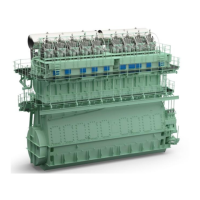Operation
4002−1/A1
Winterthur Gas & Diesel Ltd.
11/ 15
4.4.3 Initial Set-pulse
Because the rail valves are bistable, their initial position is not specified. Thus, when
the engine has stopped, set-pulses are sent to the rail valves at intervals to get a
specified position.
4.4.4 Exhaust Valve − Control
The exhaust valve movement is controlled as follows:
D The opening command of the exhaust valve is calculated in relation to the crank
angle and VEO.
D Operation of the rail valve to the open position.
D Measurement of the open deadtime: Displacement time from 0% to 15% of the
valve stroke.
D The close command of the exhaust valve is calculated in relation to the crank
angle and VEC.
D Operation of the rail valve to the closed position.
D Measurement of the close deadtime: Displacement time from 100% to 15% of the
valve stroke.
D After the crankshaft has completed one full turn, the timing for the subsequent
cycle is compared to the deadtime of the cycle before and corrected.
4.4.5 Reverse
For operation of the engine in ASTERN, the crank angle is mirrored.
4.4.6 Emergency Mode
If the valve stroke sensor becomes defective, the exhaust valve control continues with
time control for the related cylinder.
4.5 Starting Valve Control
The FCM−20 directly opens and closes the starting valve once each full turn of the
crankshaft at a specified crank angle until the engine operates.
When the engine is started in ASTERN, the crank angle is mirrored.
4.6 Crank Angle Sensor
Two crank angle sensors are installed at the free end. The crankshaft operates these
crank angle sensors through a coupling. The crank angle sensors give an absolute
angle signal (not in increments).
Each of the two signals are transmitted to each cylinder related FCM−20. The signals
are not transmitted to the online spare.
After maintenance on the crank angle sensors or their related drives, the signals must
be compared to the indication on the flywheel. If there is a difference, this must be
adjusted on the remote control.
4.6.1 Crank Angle Signals
Each of the two crank angle signals and the TDC signal are compared.
An alarm, slow-down signal or shut-down signal shows if the three signals are not in a
specified tolerance.
Engine Control System WECS-9520
2014

